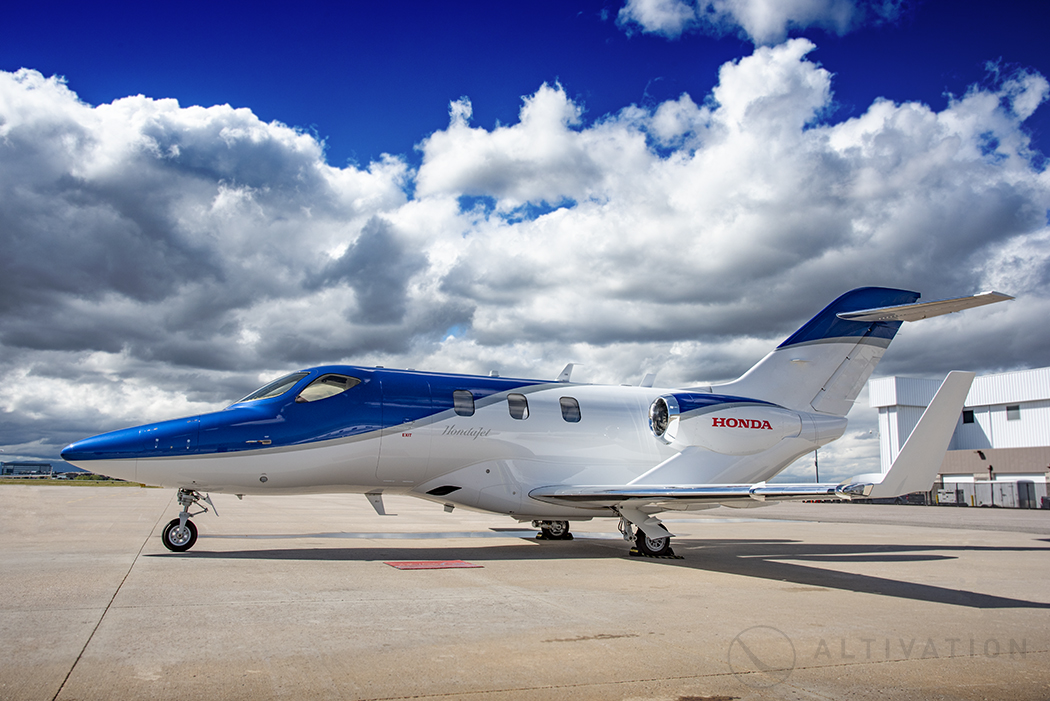
The Honda Jet is the product of decades of research and development reaching back to the late 1980’s, when Honda began its research into light aircraft. This research included the test flights of the Honda Jets predecessor, the MH-02, the world’s first all composite experimental business jet in the mid 1990’s. In 2005 the Honda Jet prototype was unveiled to the world, but it would be another 10 years of R&D before Honda would receive its FAA type certificate and deliver the first aircraft in late 2015.
At first glance of the Honda Jet, one will notice the over wing engine mount design, different then any other light business jet aircraft on the market today. This unique design comes from years of testing and development in order to reduce drag of the aircraft, allowing it operate at higher in-flight speeds. Additionally this engine placement above the wings gives the cabin additional space allowing for a large aft baggage compartment, while also reducing in cabin noise. Working to further reduce the drag of the airframe and increase the fuel efficiency of the aircraft, Honda developed its natural laminar flow aircraft nose, a unique nose design that helps air to flow more naturally around the airframe.
As you enter the carbon composite fuselage of the Honda Jet, one will find a refined executive interior with sleek lines. Inside this single pilot certified aircraft, featuring the G3000 avionics suite, is seating for up to six passengers with a side facing forward seat, and dual club seats with tables, and headliner mounted drop down displays. Aft of the main cabin and separated by a solid privacy divider, an externally serviced (option) lav with sink. This contemporary lav also features two small skylights bringing natural light into the space. Luggage is no problem in the Honda Jet, which offers a forward baggage compartment and its large rear baggage compartment, which Honda states is large enough to accommodate 6 large golf bags. In total the Honda Jet offers up to 66 cubic feet of baggage space.
With over 90 aircraft delivered in less than 3 years of service, 2018 marked other milestone as Honda announced the first refinement of the Honda Jet with the new Honda Jet Elite. The new Elite offers increased noise reduction inside and out, thanks to the redesigns in the engine inlet and fan blades. Operators of the Elite will also find increase fuel capacity providing a range increase of 17% over that of the original Honda Jet. While in the cockpit there has been improvement to a number of features of the G3000 helping to further reduce pilot work load and improve situational awareness.
In the cabin new options offered with the Honda Jet Elite include features such as an industry first Bongiovi Aviation speaker-less in cabin sounds system, utilizing 24 transducers providing passengers with an immersive in flight audio experience according to Honda. In the front of the cabin, the Honda Jet Elite now offers a full galley with built in coffee maker, and in the aft cabin an optional belted lav, certified for takeoff and landings.
While operators can expect a slightly higher acquisition cost for the Honda Jet Elite, operators should also see a reduction in the hourly operating cost. The increased fuel efficiency of the Elite should provide a slight per hour cost saving when compared to the original Honda Jets per hour estimated operating cost of $1,135 per hour. While new features and options help to push the limits of this very light jet aircraft.
View our Honda Jet Side by Side Comparison
December 2018 Newsletter article: Supplemental Lift – The Charter Option







